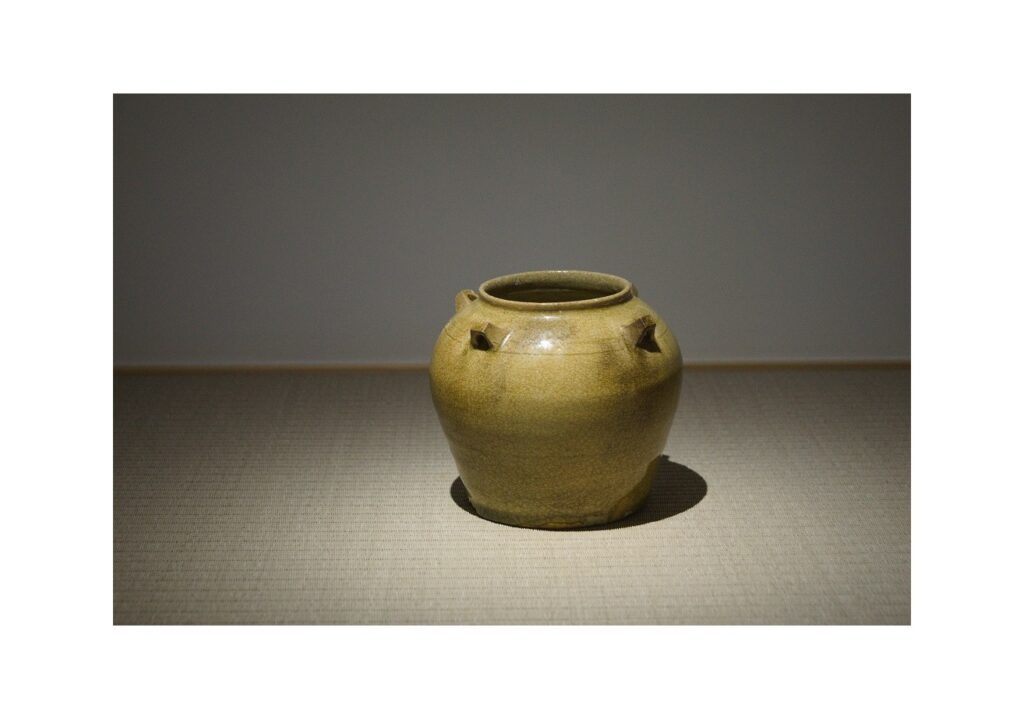(SOLD)青磁四耳小壺
- 商品名:(SOLD)青磁四耳小壺
- 時代:南朝(5~6世紀)Celadon glazed jar, 5th-6th century
- サイズ:H12.3㎝ 胴径13.5㎝
- 付属品:桐箱
愛らしい印象の青磁四耳壺です。かつては越窯とされてきた類のものですが、透明感ある淡い黄緑色の釉は、越窯のそれとは一線を画しており、唐代の「茶経」にある洪州窯の青磁と見られる向きもありますが、断定は難しいもののようです。
上海博物館所蔵の青磁蓮弁文六耳壺(「世界陶磁全集10:中国古代」所載)は、球体に近い丸壺で、口の立ち上がりはきわめて低く、肩に角耳を持ち、おそらく同じ窯の産ではないかと考えます。
シャープな四耳と、小さく愛らしい丸い姿が、ギャップを含みつつも心地よく調和した佳品です。考古的な壺でありながらも、水を入れても問題なく、シンプルな佇まいが花を引き立ててくれる、優れた実用の器でもあります。【SOLD】
It was once included in the Yue kiln. However, the transparent, pale yellowish-green glaze is unusual enough to be considered Yue ware, and some consider it to be Hongzhou ware celadon mentioned in the “Tea Sutra” of the Tang Dynasty, but it is difficult to determine for certain. A celadon six-eared jar with lotus petals in celadon in the collection of the Shanghai Museum (listed in World Ceramics Anthology 10: Ancient China) is a nearly spherical round jar with a transparent celadon skin. The mouth is extremely low, and the shoulders have sharply angular ears. Apart from the difference in the presence or absence of the design and the number of ears, it is very similar to this piece, and we believe that it was probably produced in the same kiln.
上海博物館所蔵の青磁蓮弁文六耳壺(「世界陶磁全集10:中国古代」所載)は、球体に近い丸壺で、口の立ち上がりはきわめて低く、肩に角耳を持ち、おそらく同じ窯の産ではないかと考えます。
シャープな四耳と、小さく愛らしい丸い姿が、ギャップを含みつつも心地よく調和した佳品です。考古的な壺でありながらも、水を入れても問題なく、シンプルな佇まいが花を引き立ててくれる、優れた実用の器でもあります。【SOLD】
It was once included in the Yue kiln. However, the transparent, pale yellowish-green glaze is unusual enough to be considered Yue ware, and some consider it to be Hongzhou ware celadon mentioned in the “Tea Sutra” of the Tang Dynasty, but it is difficult to determine for certain. A celadon six-eared jar with lotus petals in celadon in the collection of the Shanghai Museum (listed in World Ceramics Anthology 10: Ancient China) is a nearly spherical round jar with a transparent celadon skin. The mouth is extremely low, and the shoulders have sharply angular ears. Apart from the difference in the presence or absence of the design and the number of ears, it is very similar to this piece, and we believe that it was probably produced in the same kiln.
